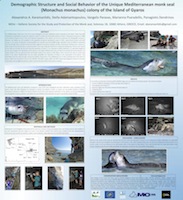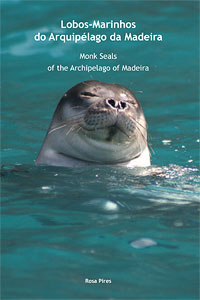Two new books announced last week focus on the extinct Caribbean monk seal, Monachus tropicalis.
 Caribbean Monk Seals: Lost Seals of the Gulf of Mexico and Caribbean Sea by John Hairr is published by Coachwhip Publications, and includes sections on the species’ various fateful interactions with humans, from native Americans to European explorers, hunters and ‘scientific’ expeditions.
Caribbean Monk Seals: Lost Seals of the Gulf of Mexico and Caribbean Sea by John Hairr is published by Coachwhip Publications, and includes sections on the species’ various fateful interactions with humans, from native Americans to European explorers, hunters and ‘scientific’ expeditions.
The publisher states: ‘The Caribbean monk seal was a significant and charismatic member of the tropical marine ecosystem of southern Florida, the Gulf of Mexico, and the Caribbean Sea. Author John Hairr delves into the fascinating history of a marine mammal that met its match in man, as overhunting for meat and oil (and even scientific specimens) drove it to extinction. Hairr looks at the intersections between this seal and the various cultures it encountered over the centuries, the narratives of a playful pinniped from the few times it was kept in captivity, and the expeditions that sought out any last remaining survivors of a vanishing species.’
Paperback: 198 pages
Publisher: Coachwhip Publications (January 3, 2011)
ISBN-10: 1616460636
ISBN-13: 978-1616460631
Price: $14.95 (USD)
 The second book, Remembering a Species: A History of the Caribbean Monk Seal in Captivity by Charles Epting, is published by Lulu, the publisher’s blurb stating: ‘This book chronicles the fascinating, untold story of the Caribbean Monk Seal: the only seal native to the Caribbean Sea, the only species of true seal that has gone extinct in recent times, and, perhaps most interestingly, the only species of recently extinct mammalian carnivore that was displayed in captivity. This book looks at both scientific sources and primary sources to gather what is known about this species’ life in captivity in one volume.’
The second book, Remembering a Species: A History of the Caribbean Monk Seal in Captivity by Charles Epting, is published by Lulu, the publisher’s blurb stating: ‘This book chronicles the fascinating, untold story of the Caribbean Monk Seal: the only seal native to the Caribbean Sea, the only species of true seal that has gone extinct in recent times, and, perhaps most interestingly, the only species of recently extinct mammalian carnivore that was displayed in captivity. This book looks at both scientific sources and primary sources to gather what is known about this species’ life in captivity in one volume.’
Paperback: 73 pages
Publisher: Lulu (December 4, 2010)
ISBN 978-0-557-92778-4
Price: $7.95 (paperback) | $3.95 (download PDF)
![]() Erdem Danyer, Işıl Aytemiz, Ali Cemal Gücü, Arda M. Tonay. 2014. Preliminary study on a stranding case of Mediterranean monk seal Monachus monachus (Hermann, 1779) on the Eastern Mediterranean coast of Turkey. Journal of the Black Sea / Mediterranean Environment 20(2): 152-157. [Download]
Erdem Danyer, Işıl Aytemiz, Ali Cemal Gücü, Arda M. Tonay. 2014. Preliminary study on a stranding case of Mediterranean monk seal Monachus monachus (Hermann, 1779) on the Eastern Mediterranean coast of Turkey. Journal of the Black Sea / Mediterranean Environment 20(2): 152-157. [Download]
 Karamanlidis, A.A., S. Adamantopoulou, V. Paravas, M. Psaradellis, P. Dendrinos. 2013. Demographic structure and social behaviour of the unique Mediterranean monk seal (Monachus monachus) colony of the island of Gyaros. Poster presentation, in: 20th Biennial Conference of the Society for Marine Mammalogy. 10th December 2013, Dunedin, New Zealand. [
Karamanlidis, A.A., S. Adamantopoulou, V. Paravas, M. Psaradellis, P. Dendrinos. 2013. Demographic structure and social behaviour of the unique Mediterranean monk seal (Monachus monachus) colony of the island of Gyaros. Poster presentation, in: 20th Biennial Conference of the Society for Marine Mammalogy. 10th December 2013, Dunedin, New Zealand. [
 Caribbean Monk Seals: Lost Seals of the Gulf of Mexico and Caribbean Sea
Caribbean Monk Seals: Lost Seals of the Gulf of Mexico and Caribbean Sea The second book,
The second book,